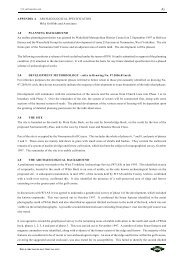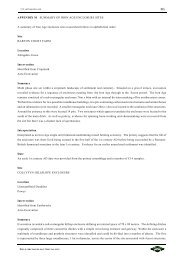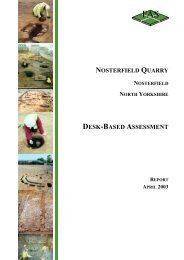ARCHAEOLOGICAL EVALUATION - Mike Griffiths and Associates
ARCHAEOLOGICAL EVALUATION - Mike Griffiths and Associates
ARCHAEOLOGICAL EVALUATION - Mike Griffiths and Associates
You also want an ePaper? Increase the reach of your titles
YUMPU automatically turns print PDFs into web optimized ePapers that Google loves.
FAS_lbf01.wpd 173<br />
10.1.3 Characterisation of the resource<br />
Evidence of past human environments at Ladybridge Farm will potentially be retained in any sediments that<br />
have been deposited or accumulated since the end of the last ice age, roughly ten thous<strong>and</strong> years ago i.e.<br />
sediments of Holocene date. This area of l<strong>and</strong> is covered in several metres of s<strong>and</strong>s <strong>and</strong> gravels of fluvio-glacial<br />
origin that are the target of the present quarrying operations (British Geological Survey 1992). These sediments<br />
were deposited during ice wasting at the end of the ice age when large volumes of water were released, sorting<br />
<strong>and</strong> re-distributing the unconsolidated sediments left by the retreating ice cover. The s<strong>and</strong>s <strong>and</strong> gravels cover<br />
glacial till <strong>and</strong> limestone bedrock that outcrops to form low rises to the east <strong>and</strong> south of Ladybridge Farm.<br />
None of these sediments offer any potential for palaeoenvironmental data of archaeological significance because<br />
they date from a period of time when there was no detectable human presence in the area. However, sediment<br />
has accumulated more recently, during the Holocene period, in two situations at Ladybridge Farm <strong>and</strong> these are<br />
potentially of palaeoenvironmental significance:<br />
<br />
<br />
Small sediment-filled gypsum subsidence hollows<br />
Larger shallow sediment-filled depressions, possibly resulting from gypsum subsidence<br />
The character of these two depositional environments <strong>and</strong> processes leading to the accumulation of the deposits<br />
are described below.<br />
Subsidence due to gypsum dissolution<br />
Ladybridge Farm lies within a narrow belt of l<strong>and</strong> in Yorkshire that is susceptible to surface subsidence due to<br />
the underground dissolution of gypsum (Powell et al 1992, British Geological Survey 1992). The hollows that<br />
are created by this process act as sediment traps, accumulating mineral <strong>and</strong> organic sediments, which are<br />
potential sources of palaeoenvironmental data. Powell distinguishes between the relatively small, discrete<br />
subsidence hollows <strong>and</strong> the larger areas of collapse: subsidence depressions. Subsidence hollows are present<br />
at Ladybridge Farm with definite examples being identified during the archaeological evaluation. Larger<br />
sediment-filled depressions have been identified at Ladybridge Farm, but it is not clear whether they are the<br />
product of gypsum dissolution or simply form irregularities in the hummocky surface of the fluvio-glacial<br />
deposits. Ice-wasting typically creates a chaotic surface topography <strong>and</strong> shallow sediment-filled hollows are<br />
typical of such hummocky terrain.<br />
L<strong>and</strong> subsidence due to gypsum is an extremely limited phenomenon in the UK. It has been reported where<br />
rocks of Permian age outcrop in a narrow zone running northwards from Nottinghamshire through Yorkshire<br />
<strong>and</strong> into County Durham. Active subsidence appears to be restricted to a much smaller area in the vicinity of<br />
Ripon in North Yorkshire; Nosterfield lies at the northern end of this active belt, which is no more than 3 km<br />
wide <strong>and</strong> 16 km long (Cooper 1986). Marl beds within the Permian rock sequence contain thick deposits of<br />
gypsum (hydrated Calcium Sulphate), which is highly soluble. Groundwater dissolves the gypsum, forming<br />
underground cavities. Progressive roof collapse allows these cavities to migrate upwards through overlying<br />
strata <strong>and</strong> break the surface, generally without warning. The upward migrating voids tend to be cylindrical pipes<br />
<strong>and</strong> when these reach the surface they form vertical-sided circular holes of varying diameter (see Klimchouk<br />
& Andrejchuk, 2003, for details of this process <strong>and</strong> explanatory illustrations). Recent examples of collapses<br />
FIELD ARCHAEOLOGY SPECIALISTS







